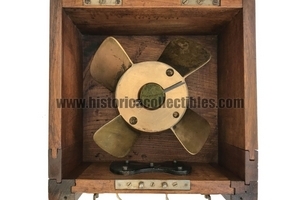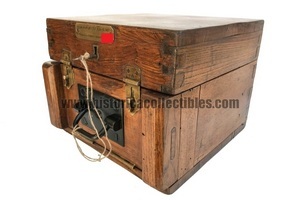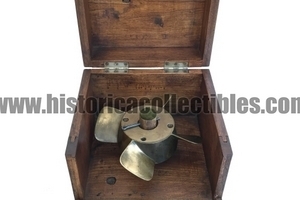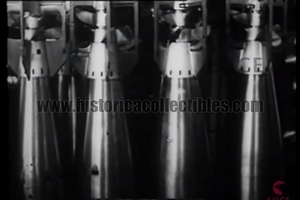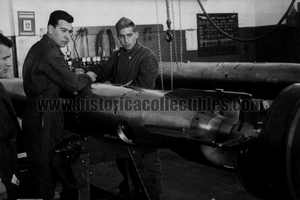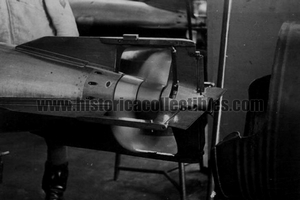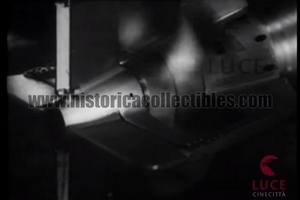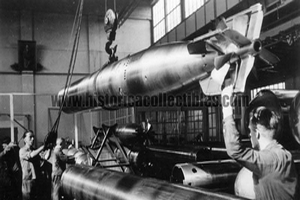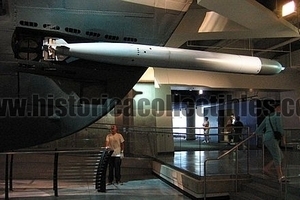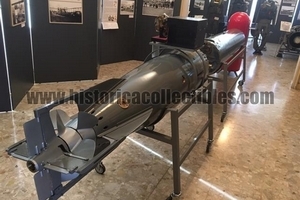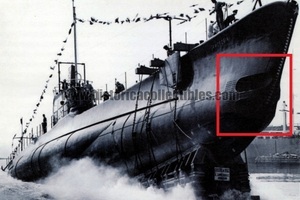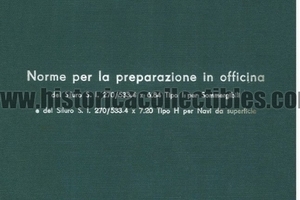Propeller for Torpedo W/270/533/6.84 G Whitehead, Royal Italian Navy, 1937
Propeller for Torpedoes mod. W/270/533/6.84 G produced by the Whitehead Fiume Silurificio in 1937 and intended exclusively for the Submarines of the Royal Italian Navy.
In fact, the production of torpedoes or torpedoes was divided as follows:
– W/270/533/7.2 for submarines, cruisers and destroyers.
– W/270/533/6.84 for submarines.
– W/200/450/5.75 for submarines and torpedo boats.
– W/170/450/5.46 for Mas and aircraft.
– SI/270/533/6.84 for submarines.
– SI/170/450/5.25 for torpedo boats, Mas and aircraft.
The turbine engine, placed inside the torpedo, rotated two independent concentric axes (one of the two rotated in the cavity of the other), onto which two propellers were keyed which rotated in opposite directions in order to eliminate the torques that the reaction of the half would have produced during the torpedo's run, which would have given rise to strong skidding. The four-bladed propellers had to be particularly robust and high-performance as the turbine engine discharged all its power through them to push the torpedo at maximum speed after launch to the target.
Made of solid marine bronze, it is preserved in its original box, a very rare specimen so complete.
The Whitehead Silurificio di Rijeka was an important industrial reality in the Kvarner city which operated for seven decades between the end of the 19th century and the first half of the 20th century.
The origins of the company date back to 1875 when the English engineer Robert Whitehead inaugurated the Torpedo Fabrik von Robert Whitehead, a plant for the production of torpedoes, in Rijeka, then a city of the Austro-Hungarian Empire.
In 1856 Robert Whitehead had been contacted to take on the role of director of the Fiume Metal Foundry which in 1858 would take on the name of Fiume Technical Plant, where some of the most modern steam engines and boilers of the time were produced and installed on ships of the Imperial Austrian Navy. Whitehead in Fiume started a collaboration with Giovanni Luppis, a Fiume native and officer of the Austro-Venetian Navy, who, wanting to find a means of defending the coasts from naval incursions, had thought of a wire-guided device which he called (in Italian) coast saver.
Luppis presented his coast saver to Emperor Franz Joseph but his invention was not successful. The device was then perfected by the collaboration between Luppis and Whitehead, giving life to the torpedo, a kind of underwater projectile propelled by a propeller set in motion automatically at the moment of launch.
The prototype, presented on 21 December 1866 to an evaluation commission of the Austro-Hungarian Navy, was evaluated positively and the two engineers were tasked with producing a first batch which would serve for experimental purposes; the Imperial-Regia Navy itself decided to acquire the non-exclusive use and reproduction rights of the torpedoes produced in Fiume. In 1871 the British Navy also decided to purchase Fiume torpedoes and the following year it was the French Navy that wanted them.
In 1873 the Fiumano Technical Plant declared bankruptcy and two years later it was taken over by Whitehead, taking the name "Torpedo Fabrik von Robert Whitehead", the first real torpedo factory in the world, thanks to advance payments from the Imperial German Navy for the construction of 100 torpedoes. 381 millimeters and the guarantee that Germany would continue to supply torpedoes, torpedo launchers and compressors at the Whitehead plant for 10 consecutive years. In the same year, Denmark, Sweden and Norway purchased Whitehead torpedoes.
In 1876 it was Russia that requested Whitehead torpedoes for its Navy and in 1877 requests arrived from Turkey, Belgium, Portugal, Argentina, Chile and Greece.
Whitehead in 1875 with a test torpedo
The company, which in 1878 already had 500 employees, saw its staff increase in just a few years, expanding its structures, becoming one of the most advanced industrial plants of its time. Inside, the factory was equipped with foundry, boilermaking, mechanical processing, assembly and testing departments. The factory also had a launch pier to test and test the torpedoes produced, and a small port where the naval units of the purchasing navies were housed, on board which the torpedo tubes were installed.
In 1891 the US Navy purchased the Whitehead torpedoes. In addition to selling the right to use and reproduce its products to various governments, the company established branches or contributed to setting up government or private torpedo factories abroad.
In 1891 a branch was established in Weymouth, United Kingdom and in 1892 another was opened in Newport, United States.
the torpedo factory in 1910.
In 1895, the generator used by the German engineer Carl von Linde (Berndorf 11 July 1842 – Munich, 16 November 1934), inventor of the refrigerator, to liquefy the air was created in the factory.
In 1905 the company became a joint stock company taking the name Torpedo Fabrik Whitehead and Co. Geselleshaft. In the same year, with Whitehead's death, the Vickers-Armstrong Whitworth group purchased the majority of the shares.
In 1907 the group signed an agreement with the Italian government for the enlargement and completion of the torpedo workshop in La Spezia, to make it suitable for the construction of torpedoes based on projects supplied by the Whitehead Torpedo Factory.
In 1910 another agreement was stipulated with the companies “Lessner and Obucoff” for the reproduction of torpedoes in Russia and in 1913 a branch was founded in Saint-Tropez, France.
In 1914 another branch was inaugurated in Naples with the name Società Anonima Italiana Whitehead for the production of torpedo launchers and compressors. The Whitehead Torpedo Factory also granted the right to reproduce its torpedoes to the American firm Bliss Leavitt of Brooklyn, which was known for studies relating to the application of turbines to torpedoes.
In the Whitehead factories, in addition to the manufacture of torpedoes, a series of related inventions were developed, created by the technicians and engineers who worked in the factory. According to what was reported by the Italian-language Croatian online newspaper La Voce del Popolo, among the inventions developed in the factory there would be the first instruments for guided missile targeting, the instrument for measuring gas pressure, the compressor for dripping water and the gyroscope and furthermore Diesel would have commissioned an engine from the Whitehead factory, cast in a single block.
From the beginning of the First World War, the Fiume torpedo factory worked exclusively for the Central Powers and following Italy's entry into the war on the side of the Entente on 24 May 1915, the production equipment was transferred from Fiume to St. Pölten, near Vienna, while in the city only the functions of a launch range remained. The fears proved to be well founded as on 2 August 1916, the factory, which was located a few kilometers west of the city, between the villages of Plase and Cantrida, was bombed by Italian planes. However, the equipment for checks and launch tests at sea was maintained in the Fiume plant.
At the end of the conflict, which ended with the defeat of the Central Powers, the factory returned to its original location in Fiume, but the company went bankrupt following the crisis that hit the city. In the Austrian factory in St. Pölten, some shareholders, with a small part of the existing machinery in the factory, founded a small company producing agricultural machinery with the name of the Whitehead Company, which however had nothing to do with the ancient Whitehead Torpedo Factory in Rijeka.
Following the Treaty of Rome, signed on 27 January 1924, which sanctioned the passage of the city of Fiume to Italy upon the involvement of General Giardino, future Marshal of Italy and governor of the Free State of Fiume between 1923 and 1924, the establishment was refounded with 230 employees.
The General intervened with the Italian entrepreneurial group of Engineer Giuseppe Orlando who had taken over the management of the Ganz Danubius Shipyards, another large industrial company in Fiume, to also take over the torpedo factory.
In February 1924 the "Whitehead Plant-Anonymous Operating Company" was established for the management of the torpedo factory, which thus resumed its activity under the direction of the same engineer Orlando, appointed president of the company; between 1924 and 1934, the company which in 1928 took the name of Silurificio Whitehead di Fiume S.A., was modernised, with the purchase of new machinery, the expansion of the workshops, the construction of a new launch station and a catapult for torpedoes intended for airplanes.
Between 1924 and 1934, 1266 torpedoes of various torpedo types were produced not only for the Regia Marina, but also for the navies of Spain, Argentina, the Netherlands, Yugoslavia, Turkey, Finland and the Soviet Union. The company, which had a surface area of 35,000 m² of which 22,500 were covered, had 750 workers, mostly specialists, and around a hundred technical and administrative employees.
Due to debts, the torpedo factory in Naples was put into liquidation by the British group at the end of 1921 and in April 1922 Comit, which was the company's largest creditor, took over the plant which was called the "Italian Torpedo Factory". The Royal Navy responded to the company's crisis by proposing the replacement of the 450mm torpedo with the 533mm torpedo considered more efficient.
In 1933 IRI came into possession of 40% of the shares of the "Silurificio Whitehead" through the Società Finanziaria Italiana, the financial company of Credito Italiano, and of all the shares of the "Silurificio Italiano" through the Società Finanziaria Industriale Italiana, the financial statement of the Comit.
In 1937 the Fiume company opened its branch in Livorno, which a few years later was called Società Moto Fides and in both cities the war production activity was frenetic due to the arms race that characterized the period preceding the Second World War. world War.
The Livorno factory, however, was not yet capable of building Whitehead torpedoes and its activity was initially limited to the construction of parts for the torpedoes built in Fiume and only towards the end of 1941 did the first complete torpedoes emerge from the factory in the Tyrrhenian city. The factories in Fiume and Livorno were supported in the production of torpedoes for the Royal Navy, by the Silurificio Italiano which had transferred its production to a factory set up in 1936 by converting a shipyard in the Campi Flegrei area, using the old factory as a torpedo.
During the Second World War, in which the production of torpedoes was significantly increased, in the days preceding the invasion of Yugoslavia by the Axis on 31 March 1941 with the civil mobilization order issued by the prefect Temistocle Testa, the workers of the torpedo factory, with the most important equipment were transferred to Livorno and what remained of the Whitehead plant was decentralized to more internal locations, such as Valvasone and Fiume Veneto, with reduced production capacities, while the oil and petrol from the R.O.M.S.A. refinery. they were placed in safety in Trieste.
In 1942, 1,170 torpedoes were produced in the plant, while in 1943 the production record of 160 torpedoes in one month was achieved. In Naples, to cope with an increase in production, a new plant was built in the flat area of Fusaro.
From 10 June 1940, the day of entry into the war, to 8 September 1943, the day of the armistice, Italy consumed 3,700 torpedoes, mainly of the new 533 mm type.
Following the proclamation of the armistice, the city was occupied by the Germans and apparently became part of the operations area of the Adriatic coast. Starting from the beginning of 1944, the city was heavily bombed by the Anglo-Americans and the Allied bombings caused hundreds of deaths and damaged a large part of the port and industrial structures. Following the occupation of Fiume by the Yugoslav resistance forces, led by Tito, which took place on 3 May 1945 and which would be formalized by the Peace Treaty on 10 February 1947 with the annexation of the city to Yugoslavia, Whitehead it was merged on 31 July 1945 with the Moto Fides torpedo factory of Livorno, transferring its activity to the Tuscan city with the name Whitehead-Motofides, while in Fiume the former Whitehead factory became the headquarters of a mechanical company with the name "Torpedo".

